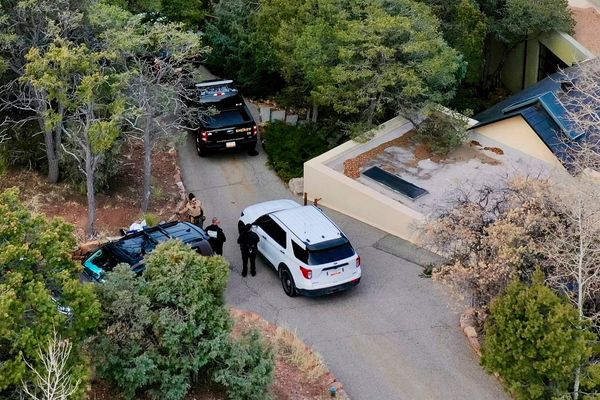
Last summer, three little girls were murdered at a Taylor Swift themed yoga and dance workshop in Southport. Bebe King, age six, and Elsie Dot Stancombe, age seven, were so severely wounded, said the pathologist, that they could not have survived. They died at the scene. Nine-year-old Alice da Silva Aguiar managed to escape, but he injuries were also so severe that she died in hospital the next day.
When police arrived they found Axel Rudakubana, aged 17, still holding the kitchen knife he had ordered online from Amazon. Whilst under arrest, he reportedly told officers: “It’s a good thing those children are dead… I’m so glad… I’m so happy.” Disinformation about the killer’s identity proliferated, sparking weeks of racially motivated anti-immigration riots across the country.
Rudakubana’s trial was due to begin this week, with the teenager having previously entered a not guilty plea. But on Monday, he plead guilty to all 16 charges: three of murder, 10 of attempted murder, one of possession of a knife, along with charges for the production of the biological toxin ricin, and for possession of a terrorism-related PDF file. He cannot be sentenced to a whole life order as he was too young under the law at the time of the attack.
“His only purpose was to kill”
At today’s sentencing hearing, the terrible facts of the now 18-year-old’s crimes have been laid bare. “Three children were killed, two of those children suffered particularly horrific injuries which are difficult to explain as anything other than sadistic in nature,” said prosecutor Deanna Heer KC. The court heard how the killer lunged at the class of 26 children, stabbing some of them in the back as they fled and dragging one back inside as they tried to escape.
While the killer’s internet history was filled with gory documents filled with violence and genocide, he subscribed to no over-arching political or religious ideology. “He wasn’t fighting for a cause,” said Heer. “His only purpose was to kill and he targeted the youngest, most vulnerable in our society in order to spread the greatest level of fear and outrage, which he succeeded in doing.”
There will be no trial and no further exploration of the killer’s motives in court. Attention has already turned to apparent missed opportunities to apprehend the teenager before he killed and maimed. Home Secretary Yvette Cooper has launched an inquiry into the case to investigate how the killer “came to be so dangerous”. “I will not let any institution of the state deflect from their failure,” said Prime Minister Keir Starmer. “Failure which in this case, frankly, leaps off the page.”
Missed opportunities
A former schoolmate described the killer to The Guardian as “a ticking time bomb”. The killer had been excluded from mainstream education in 2019 for bringing a knife to school, claiming he had been racially bullied. He returned to the school armed with a hockey stick with teacher and pupils names written on them, threatening to attack them. According to residents on his street, his father had stopped him from attempting to take a taxi to his former school just days before the attack.
The killer was known to local social services, who often requested the police attend their meetings for security. He had been referred to Prevent three times between 2019 and 2021. But because he displayed no coherent ideology, the anti-radicalisation programme did not take the referrals any further. An extensive interest in the macabre alone – in genocides and dictators, in mass murderers and violent periods of history – did not contravene current terrorism laws.
The killer had also seemingly produced an amount of the biological weapon ricin, in contravention of the Biological Weapons Act 1974. He also had a PDF file “of a kind likely to be useful to a person committing or preparing an act of terrorism”, per the Merseyside Police. The document, which is easily available with a quick internet search, includes replications made by the American military of an Al-Qaeda training manual.
There are few clues about the killer’s childhood that are publicly available. The killer’s parents, Alphonse and Laetitia Muzayire, relocated to Southport from Rwanda before he was born. His family are Tutsis, part of the ethnic group that was slaughtered en masse by ethnic Hutu extremists in 1994. Professionals working with the killer reported that he was particularly fascinated by the Rwandan genocide.
Terror and misogyny
Whatever the Southport killer’s motivation or mental state, the killer targeted a class of little girls celebrating one of the world’s biggest pop stars, for maximum impact.
Groups such as Women’s Aid have condemned the attack as part of a wider pattern of violence against women and girls. Like many mass killings, women were either the express target, or the perpetrator has been framed as driven to violence by anger at women in their lives. Sometimes these attacks inspire each other. Material relating to London-born killer Elliot Roger, who published a misogynistic incel manifesto before killing six people in California in 2014, was accessed online by both the Toronto van attacker who killed 10 people in 2018 and the Plymouth gunman in 2021.
Misogynistic attacks sparking terror show no signs of abating. 2025 had barely dawned before a man in New Orleans, frustrated by his divorce and custody proceedings, drove a rented truck into a crowd of revellers killing 14 people. One of his ex-wives had already taken out a restraining order against him. The New Orleans killer had an ISIS flag in his vehicle, but no official connection to the terror organisation. On Monday, Chinese authorities executed a man convicted of killing 25 people in a car attack last November. This killer was reportedly unhappy about his divorce settlement.
Extreme violence against women has made the Southport killer notorious, and the violent race riots it spawned only added to his notoriety. Last August, Home Secretary Cooper promised that extreme misogyny would be included in new terror laws.
Violent obsession
Attempts to divine a single reason coherent logic in the Southport killer’s motivations are futile. Any psychiatrist that attempts to offer a public diagnosis would be acting unethically. But what we do know is that the Southport stabbings were part of a wider pattern of violent mass attacks. It is a type of terror attack that does not conform to an ideology beyond a fascination with extreme violence.
In December 2024, UK counter-terrorism lead Vicki Evans warned that a rise in young people accessing extreme content online is creating a different terrorist threat that organisations such as Prevent are ill-equipped to handle. “We are seeing search histories which contain violence, misogyny, gore, extreme pornography, racism, fascination with mass violence, school massacres, incel, and sometimes that’s coupled with terrorist material,” said Evans, who is the Met Deputy Assistant Commissioner. “It is a pick and mix of horror.”
Starmer may have called the attack a “new and dangerous threat”, but experts have been warning politicians for years about the risk of lone angry men externalising their violent, often misogynistic, impulses on strangers. The Prime Minister has now acknowledged the risk of “acts of extreme violence perpetrated by loners, misfits, young men in their bedroom accessing all manner of material online – desperate for notoriety, sometimes inspired by traditional terrorist groups, but fixated on that extreme violence, seemingly for its own sake.”
It will be years before results of the inquiry, with now clear roadmap for the government to address this threat. The question isn’t if there will be another attack from a violence-obsessed man looking for infamy in the meantime, but when.







